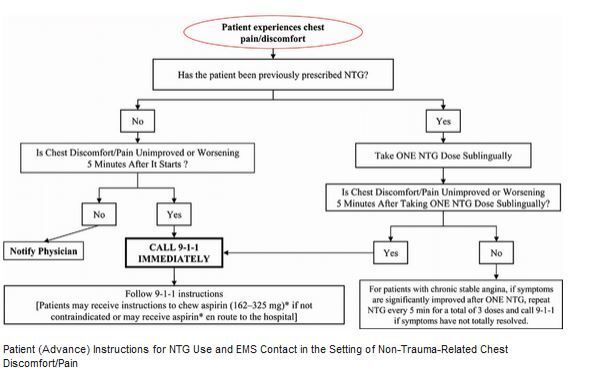Course
Importance of Patient Education in the Early Recognition of STEMI
Course Highlights
- In this course we will explore the importance of patient education in the early recognition of STEMI.
- You’ll also learn the basics of a STEMI and its symptoms.
- You’ll leave this course with a broader understanding of how to conduct interventions to reduce risk in your patients.
About
Contact Hours Awarded: 1

Course By:
Morgan Curry
BSN, RN
Begin Now
Read Course | Complete Survey | Claim Credit
➀ Read and Learn
The following course content
An acute ST-elevation myocardial infarction (STEMI) continues to be a significant health problem in the United States and throughout the world. Despite this, there has been a steady decline in the mortality rate from STEMI over the last several decades (2). A STEMI is a high-risk condition in which survival and other clinical outcomes are significantly impacted by reducing the time from vessel occlusion to coronary blood flow restoration (1). Thus, it is crucial for health care providers to educate their patients in recognizing and identifying early symptoms of a STEMI to improve outcomes and mortality.
Introduction
An acute ST-elevation myocardial infarction (STEMI) continues to be a significant health problem in the United States and throughout the world. Despite this, there has been a steady decline in the mortality rate from STEMI over the last several decades (2). A STEMI is a high-risk condition in which survival and other clinical outcomes are significantly impacted by reducing the time from vessel occlusion to coronary blood flow restoration (1). Thus, it is crucial for health care providers to educate their patients in recognizing and identifying early symptoms of a STEMI to improve outcomes and mortality.
An acute ST-elevation myocardial infarction (STEMI) is when myocardial ischemia results in myocardial injury or necrosis. A STEMI occurs from the occlusion of one or more of the coronary arteries responsible for supplying the heart with blood. The disruption of blood flow is caused by plaque rupture, erosion, fissuring, or dissection of coronary arteries resulting in an obstruction (1).
Recommendations for Management Prior to Occurrence
According to the American Heart Association, “One-third of patients who experience STEMI will die within 24 hours of the onset of ischemia, and many survivors will suffer significant morbidity (2).” Overall, 655,000 Americans die of coronary artery disease (CAD) (2).
Many patients’ first manifestations of CAD will be sudden death. Clinical studies have shown that modification of risk factors for the development of CHD and STEMI can prevent the growth of CHD or reduce the risk of experiencing STEMI in patients who have CHD (2). Healthcare providers should identify patients with risk factors contributing to developing a STEMI long-term.
How to Identify Those at Risk for STEMI
Identifying patients at risk for developing a STEMI as healthcare providers is the first step in preventing STEMI. Primary Prevention refers to trying to stop a patient from getting the disease. Secondary Prevention is detecting disease in the early stages and preventing it from worsening. Tertiary Prevention refers to improving the quality of life of a patient by reducing the symptoms of the disease that one already has (4).
Major risk factors for developing CAD (3):
- Smoking
- Family history
- Adverse lipid profiles
- Elevated blood pressure
Primary prevention interventions directed toward these risk factors are effective when used correctly. Patients with diagnosed CAD should be identified for secondary Prevention, and those steps should be implemented on a patient-by-patient basis. Patients with diabetes and peripheral vascular disease have a baseline risk of STEMI (2).
A committee from the American Heart Association strongly endorses various public health campaigns that are believed to contribute to reducing incidence and fatality in patients with STEMI in the future. These include (2):
- Recognition of diabetes mellitus and chronic kidney disease as “risk equivalents” to coronary heart disease and recommends aggressive attempts to control these risk factors
- Recognition of the importance of dyslipidemia as a significant risk factor for coronary heart disease and recommends aggressive attempts at cholesterol reduction and treatment of this issue.
- Aggressive primary smoking cessation
- Patient education regarding the signs and symptoms of MI and appropriate courses of action
- Implementation at a professional level of quality assurance projects such as the ACC’s Guidelines Applied in Practice to improve compliance with treatment strategies when caring for patients with MI

Self-Quiz
Ask Yourself...
- How many patients have you taken care of that have risk factors of CHD?
- Have you ever provided a patient with education of these risk factors? What did that involve?
Interventions to Reduce Risk
According to the American Heart Association, the following are interventions to reduce the risk of the development of a STEMI (2):
- All patients who smoke should be encouraged to quit and provided with appropriate cessation education.
- All patients should be instructed to maintain appropriate low-saturated-fat and low-cholesterol diets.
- Pharmacological intervention with statins should be prescribed to patients when appropriate.
- Patients with high blood pressure should be treated and maintained.
- Aspirin prophylaxis can uncommonly result in hemorrhagic complications and should only be used in primary Prevention.
STEMI Classic Symptoms
- Chest discomfort with OR without radiation to the arm (s), back, neck, jaw, or epigastrium
- Chest pressure, tightness, or squeezing
- Shortness of breath
- Weakness
- Diaphoresis
- Nausea
- Lightheadedness
- Palpitations
Men VS. Women
Men’s most common heart attack symptom is chest pain (angina) or discomfort. Women are more likely than men to experience other symptoms, particularly shortness of breath, nausea/vomiting, and back or jaw pain (3).
Patient Education for Early Recognition
It is crucial to educate patients on their disease process, their risk factors, and the common warning signs to watch for in an emergent situation. Patients with symptoms of STEMI should call 9-1-1 immediately. For patients experiencing a heart attack, every minute counts. EMS can begin treatment upon arrival—up to an hour sooner than if someone travels to the hospital by car (2).
For patients who have been prescribed nitroglycerine, they should take one nitroglycerine dose sublingually in response to chest/discomfort. If discomfort is not relieved after 5 minutes, the patient or family member should call 9-1-1 (2). Morbidity and mortality can be substantially reduced by educating patients and patients taking action upon recognition of symptoms.

Self-Quiz
Ask Yourself...
- Can you think of other ways that women present differently than men in signs and symptoms of diagnosis?
- If a patient is diaphoretic and experiencing jaw pain, what should their first intervention be?
- A male patient was experiencing chest pain and was diaphoretic. He told his wife to drive him to the hospital rather than waiting for the ambulance to arrive. Is this best practice or recommendation?
STEMI Onset
Before evaluation and potentially life-saving treatment, early recognition of symptoms by the patient or close to the patient is the first step that must occur. According to the American Heart Association, “The average patient with STEMI does not seek medical care for approximately 22 hours after system onset (2).” Below is a chart advocated by the American Heart Association that identifies the most common signs of an impending cardiac event that requires emergent care.

Silent, yet Deadly
Patients who experience STEMI do not always present with chest discomfort. Of the patients diagnosed as having an MI, 33% did not have chest pain upon presentation to the hospital. This group of patients was, on average, seven years older than those who experienced chest pain and were women with a prior history of heart failure or diabetes (3). According to the American Heart Association, “In the majority of clinical studies that have been examined to date, women have been shown to exhibit more prolonged delayed patterns compared to men often because they do not always perceive themselves to be at risk (3).”
Based on the REACT research program, patients commonly expect a heart attack to present dramatically with severe, crushing chest pain without a doubt that something bad is occurring. This contrasts with the reported symptoms and experiences of the same patient’s gradual discomfort with midsternal chest pressure or tightness (2). Many patients know that chest pain is a bad sign. But they often do not know when to react to that sign and when too long is too late. Patients must know the other ways a heart attack can present and understand the importance of not delaying seeking help.
Conclusion
In conclusion, early identification of risk factors in patients with combined primary and secondary Prevention and thorough and explicit patient education and management will significantly improve clinical outcomes of a STEMI event. Because the irreversible damage to the myocardium occurs within the first two hours after coronary occlusion, it is imperative that warning signs are recognized and the patients seek treatment for reperfusion regardless of the type of intervention -fibrinolysis or percutaneous coronary intervention (PCI) (5).
References + Disclaimer
- Akbar H, Foth C, Kahloon RA, et al. Acute ST-Elevation Myocardial Infarction. [Updated 2020 Aug 8]. In: StatPearls [Internet]. Treasure Island (FL): StatPearls Publishing; 2020 Jan-. Available from: https://www.ncbi.nlm.nih.gov/books/NBK532281/
- Uddin, M., Mir, T., Khalil, A., Mehar, A., Gomez-Pineiro, E., Babu, M., Sheikh, M., Sheikh, M., Soubani, A., Saydain, G, & Afonso, L. (2022). ST-elevation myocardial infarction outcomes: A United States nationwide emergency departments cohort study. The Journal of Emergency Medicine, 62(3), 306-315. https://doi.org/10.1016/j.jemermed.2021.10.028
- https://www.heart.org/en/health-topics/heart-attack/warning-signs-of-a-heart-attack
- Prasad, K. (2021). Current status of primary, secondary, and tertiary Prevention of coronary artery disease. International Journal of Angiology, 30(3), 177-186. https://doi.org/10.1055/s-0041-1731273
- Reeder, G., & Kennedy, H. (2022). Overview of the acute management of ST-elevation myocardial infarction. https://www.uptodate.com/contents/overview-of-the-acute-management-of-st-elevation-myocardial-infarction
Disclaimer:
Use of Course Content. The courses provided by NCC are based on industry knowledge and input from professional nurses, experts, practitioners, and other individuals and institutions. The information presented in this course is intended solely for the use of healthcare professionals taking this course, for credit, from NCC. The information is designed to assist healthcare professionals, including nurses, in addressing issues associated with healthcare. The information provided in this course is general in nature and is not designed to address any specific situation. This publication in no way absolves facilities of their responsibility for the appropriate orientation of healthcare professionals. Hospitals or other organizations using this publication as a part of their own orientation processes should review the contents of this publication to ensure accuracy and compliance before using this publication. Knowledge, procedures or insight gained from the Student in the course of taking classes provided by NCC may be used at the Student’s discretion during their course of work or otherwise in a professional capacity. The Student understands and agrees that NCC shall not be held liable for any acts, errors, advice or omissions provided by the Student based on knowledge or advice acquired by NCC. The Student is solely responsible for his/her own actions, even if information and/or education was acquired from a NCC course pertaining to that action or actions. By clicking “complete” you are agreeing to these terms of use.
➁ Complete Survey
Give us your thoughts and feedback
➂ Click Complete
To receive your certificate
